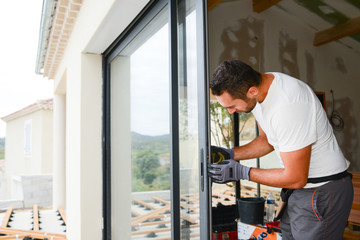Windows are more than just openings to the outdoors; they frame your view, let in natural light, improve ventilation, and enhance the look and energy efficiency of a building. Whether you’re building a new home, renovating, or upgrading old frames, proper window installation is essential to achieve both aesthetic appeal and long-term performance. Done well, it can transform a room, reduce energy costs, and add significant value to your property.

Why Window Installation Matters
A window that looks beautiful but is poorly installed can cause drafts, leaks, and increased energy bills. On the other hand, a correctly installed window will provide insulation, soundproofing, and durability for years. The installation process affects not only how the window functions but also the safety and comfort of the space.
Good installation prevents water intrusion, reduces condensation, and ensures the frame remains square and secure. It also makes maintenance easier over time and enhances the life span of the unit.
Preparing for the Project
Successful window installation starts with careful planning. Begin by assessing the area where the window will go. Measure the opening accurately to ensure the new unit will fit properly. Account for the thickness of trim, insulation, and any shimming needed to make the frame level.
Consider the purpose of the room and how much light or ventilation you want. Think about energy efficiency, style, and ease of cleaning. All of these factors help you choose the right type and size before the actual installation begins.
Removing Old Windows Safely
If you’re replacing existing windows, removing the old ones requires care. Protect interior finishes and surrounding walls from damage by using drop cloths and prying gently around trim. Remove old caulking, nails, and screws to free the frame.
Inspect the opening for rot, mold, or structural issues. Any damage to the sill or framing should be repaired before installing the new window. This step ensures a stable base and prevents future problems.
Ensuring a Proper Fit
One of the most important parts of window installation is making sure the unit sits level, plumb, and square in the opening. Shims—small pieces of wood or plastic—are often used to fine-tune the fit. Even a small misalignment can lead to gaps that allow air or water infiltration.
Check the window’s operation before securing it permanently. Open and close the sashes to ensure smooth movement and alignment. Adjust shims as needed until everything functions correctly.
Sealing for Energy Efficiency
Proper sealing is essential to keep drafts and moisture out. Use high-quality caulk or foam insulation around the perimeter of the frame, taking care not to overfill gaps, which can warp the frame.
Weatherstripping around movable parts adds an extra layer of protection. A well-sealed window improves comfort, lowers energy costs, and helps maintain indoor temperatures year-round.
Securing the Window
Once the window is in place and sealed, it needs to be fastened securely to the surrounding structure. Follow the manufacturer’s recommended fastening points, as over-nailing or screwing in the wrong places can damage the frame or void warranties.
After fastening, recheck the operation. A window that’s been pulled out of square during fastening may stick or fail to lock properly. Adjust as needed before installing interior or exterior trim.
Finishing Touches
Trim and flashing complete the installation and protect against water damage. Exterior flashing channels water away from the window, while interior trim creates a neat, polished look. Use paint or stain to match surrounding finishes, ensuring the window complements the room’s design.
Adding blinds, curtains, or shades after installation can enhance privacy and control light while protecting furnishings from UV rays.
Safety Considerations
Windows can be heavy and awkward to handle, especially large units. Always lift with proper technique or get help to avoid injury. Wear gloves to protect your hands from sharp edges, and safety glasses when prying or cutting.
If the installation requires working at height, such as on a second story, use secure ladders or scaffolding. Taking safety seriously protects both you and your investment.
Common Mistakes to Avoid
A few common errors can compromise window performance:
- Inaccurate measurements – Even small miscalculations can lead to gaps or costly reorders.
- Skipping the level check – A window that isn’t plumb or square won’t seal or operate properly.
- Insufficient sealing – Poor caulking or missing flashing can lead to leaks and rot.
- Rushing the job – Window installation takes patience; rushing increases the chance of mistakes.
By avoiding these pitfalls, you ensure a smoother project and better results.
When to Call a Professional
While many homeowners successfully install their own windows, larger projects or specialized units may require professional expertise. Professionals have the tools, skills, and experience to handle tricky situations, such as custom shapes, structural changes, or multi-story work.
Even if you’re confident in your skills, consulting an expert for guidance can help you plan the job correctly and avoid costly errors.
The Benefits of Well-Installed Windows
A properly installed window offers more than just a view. It improves energy efficiency, reduces outside noise, and increases natural light. It can make your home feel fresher and more inviting while boosting its market value.
Over time, good installation saves money by reducing the need for repairs, preventing water damage, and lowering utility bills. It also enhances security, as a firmly anchored window is harder to force open.
Window installation is both a technical and aesthetic task. Done thoughtfully, it enhances comfort, safety, and beauty for years to come. By preparing carefully, ensuring a precise fit, sealing thoroughly, and finishing neatly, you create windows that perform as well as they look.
Whether you tackle the job yourself or hire professionals, understanding the key steps in window installation helps you make informed decisions and achieve a successful outcome. With patience and attention to detail, you can transform any room with light, air, and a clear view of the world outside.